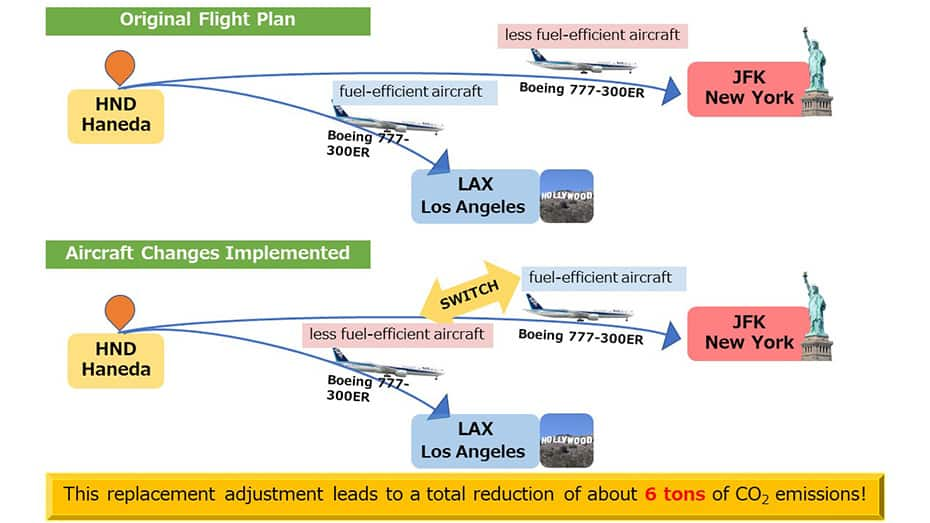- Please select the card you wish to join
-

Get your digital card immediately
No enrollment or annual fees
ANA Mileage Club Card
Earn more miles for your money
With credit function
ANA Card
May 26, 2022
ANA Operations Management Center (hereinafter referred to as "OMC"), which manages the flight operations and schedules of all ANA-branded flights, is mainly responsible for creating flight plans for each flight and formulating flight operation policies for irregular occasions. OMC is also environmentally conscious, and is working to significantly reduce CO₂ emissions through detailed fleet adjustments, such as which aircraft to use and which routes to fly in an environmentally friendly manner.
ANA Operations Management Center (OMC) operations
OMC is located in Terminal 1 at Haneda Airport and manages nearly 1,000 ANA-branded flights per day on a 24-hour basis. OMC constantly monitors all the flight operations, formulates flight operation policies in the event of irregularities due to inclement weather or aircraft malfunctions, and makes subsequent revisions to the schedule.

The work view of OMC
In addition, OMC is working to reduce CO₂ emissions by assigning fuel-efficient aircraft to the most appropriate routes. As a result of daily operations, the combination of aircraft and routes continues to change over and over again. It is possible to stay with the original combination, which creates no extra work, but in order to minimize CO₂ emissions and ensure environmentally friendly operations, OMC reviews the schedule of aircraft and route combinations from the following day onward, and gives priority to fuel-efficient aircraft above the same configuration (same number of seats and same seat layout). This allows OMC to contribute to the reduction of CO₂ emissions without inconveniencing passengers since there is no change in seat assignment.
Allocation of fuel-efficient aircraft
It is well known that different models and types of aircraft, such as the Boeing 777 and Boeing 787, consume different amounts of fuel even when flying the same distance. In fact, even the same Boeing 777-300ER aircraft can each have different fuel efficiency performance because the fuel flow in the engine and the air resistance the aircraft receives are different from one aircraft to another. In general, the longer the aircraft has been in use and the longer the accumulated flight distance, the lower the fuel efficiency will be. However, there is always a difference in the fuel efficiency performance of each aircraft, because the fuel efficiency can be improved by performing water-wash operations to clean the inside of the engine or by replacing the engine itself.
The fuel efficiency of each aircraft is calculated based on monthly flight performance data, and the appropriate amount of fuel to be carried on each flight is reflected in the flight plan. OMC utilizes this difference in fuel efficiency to help reduce CO₂ emissions by prioritizing the use of fuel-efficient aircraft and assigning them to longer routes.
For example, suppose there are flights from Haneda Airport to New York and flights from Haneda Airport to Los Angeles, using the same Boeing 777-300ER aircraft. If a fuel-efficient aircraft is assigned to a Los Angeles-bound flight in the schedule, it can be switched with a longer-haul New York-bound flight to assign a fuel-efficient aircraft for the longer distance, thereby contributing to an overall reduction in CO₂ emissions.

Figure showing how OMC reduces CO₂ emissions by switching the aircraft
This optimization of aircraft and route assignment has contributed to a reduction of approximately 1,300 tons of CO₂ emissions per year on domestic routes and approximately 2,000 tons of CO₂ emissions per year on international routes.
Interview with the person in charge
We interviewed Mr. Morita of the Operations Management Department, ANA Operations Management Center.

What inspired you to start this initiative?
The trigger was a major change in the work environment when the COVID-19 began in 2020. We started thinking about this environmentally-friendly initiative, when the number of irregular operations and flight schedule revisions that had been the front-line operations drastically decreased due to the flight reductions.
What are some of the day-to-day challenges you face in this initiative?
At times, aviation operations can be compared to a living creature. This is an example of how the weather can easily exceed our expectations and predictions, as if it were mocking them, no matter how much foresight we have. The moment we reconfigure the aircraft and routes to the best possible combination, we are often forced to change that combination (e.g., to recover from a delay due to bad weather, or to change the aircraft due to a maintenance plan), and the probability of operating the flight as planned is about 60-70%. I think it is important not to think of the 30-40% that did not fly as planned as a useless adjustment, but to keep motivation high and to continue to work diligently. This initiative is not something that is adjusted once and finished, but must continue 24 hours a day, 365 days a year in order to produce results, so I believe the key is to maintain such an "attitude" and "mindset".
What is your outlook for the future?
In the future, I hope to make airplanes environmentally friendly vehicles. The transportation sector accounted for 18.6% (about 206 million tons) of Japan's total CO₂ emissions (about 1.108 billion tons) in FY 2019 before the spread of COVID-19, with the aviation industry emitting 5% of that (about 10.49 million tons) which is 1.0% of the total.
The term "flight shame" is created by the image of air travel as an environmentally unfriendly mode of transportation, and in fact, compared to other forms of public transportation such as railroads, airplanes emit more CO₂ per unit of transportation volume. Although technological innovation is indispensable to change this reality and image, I hope that this article will help more people learn about the immediate and steady efforts that can be made to reduce CO₂ emissions, and that the "chain" of reduction will expand not only in the aviation industry, but also in the industrial and residential sectors.
It is said that the decade from 2020 to 2030 will be the turning point that will determine the future of the global environment. As an airline company, we would like to continue to operate our flights in an environmentally friendly manner with as many passengers as possible.
ANA will continue to take its responsibility as an airline company and contribute to the reduction of CO₂ emissions.



Related Tags
-
Reservations
-
MILES
-
MILES
-
Login
-
Support




